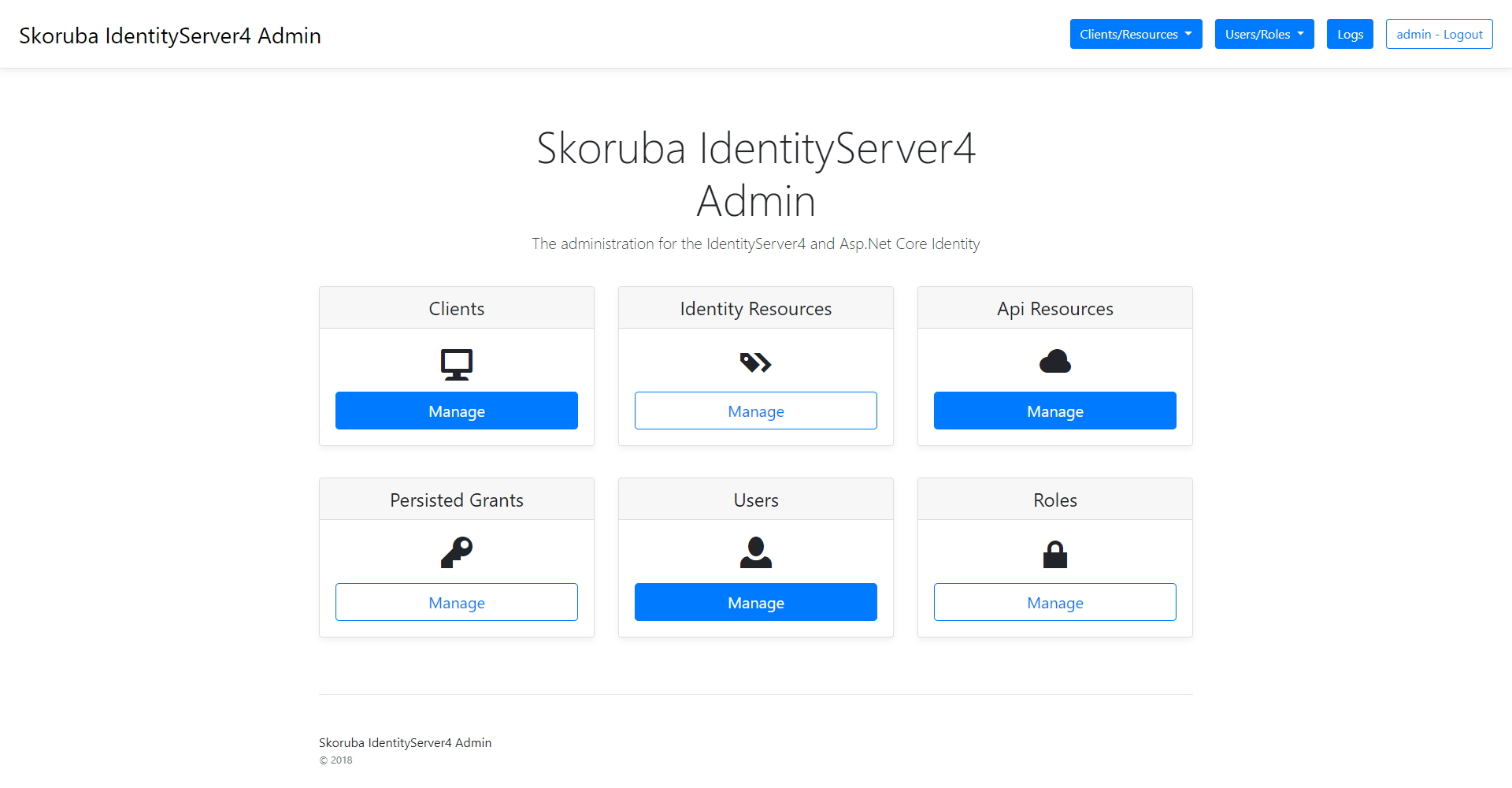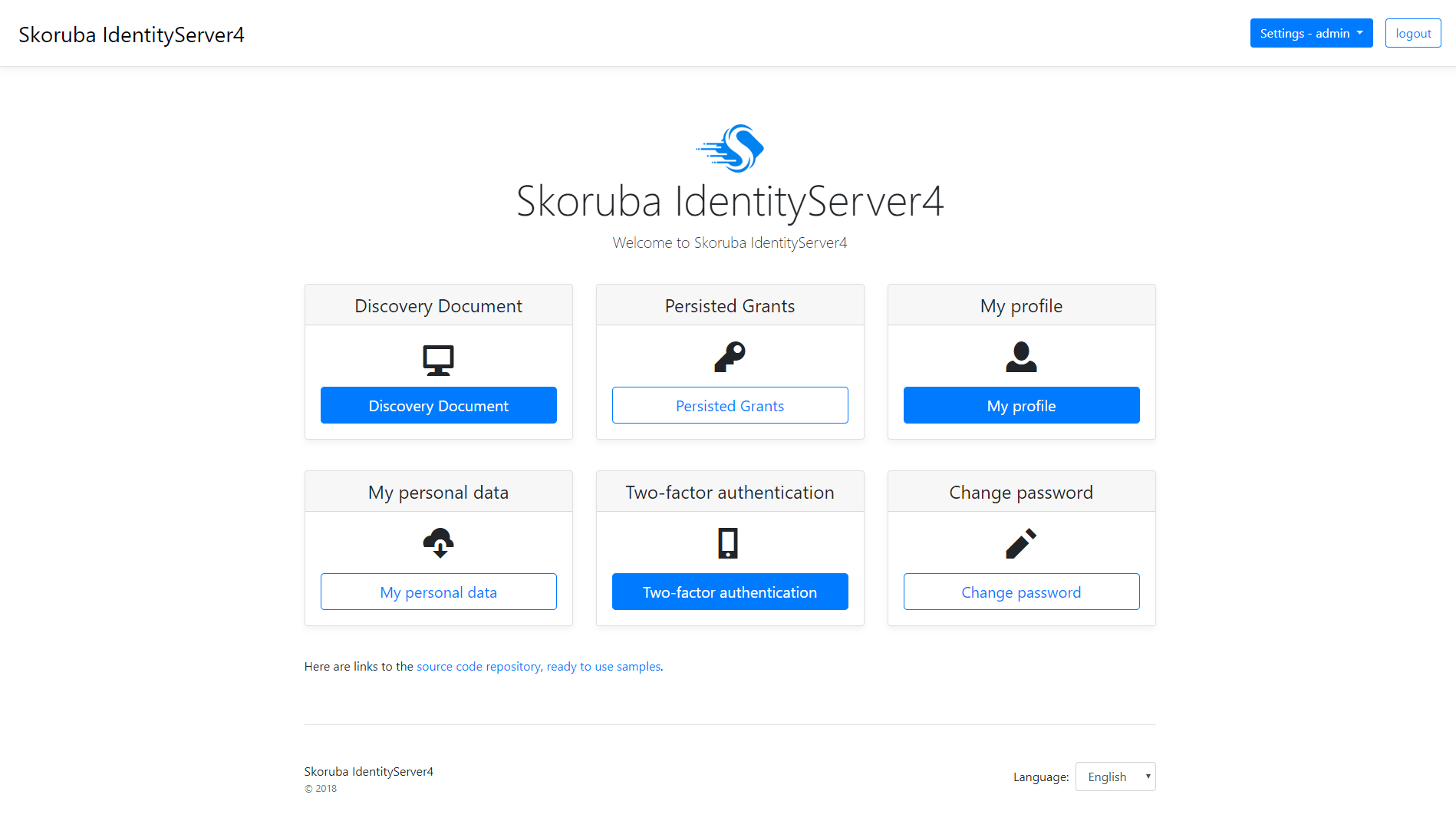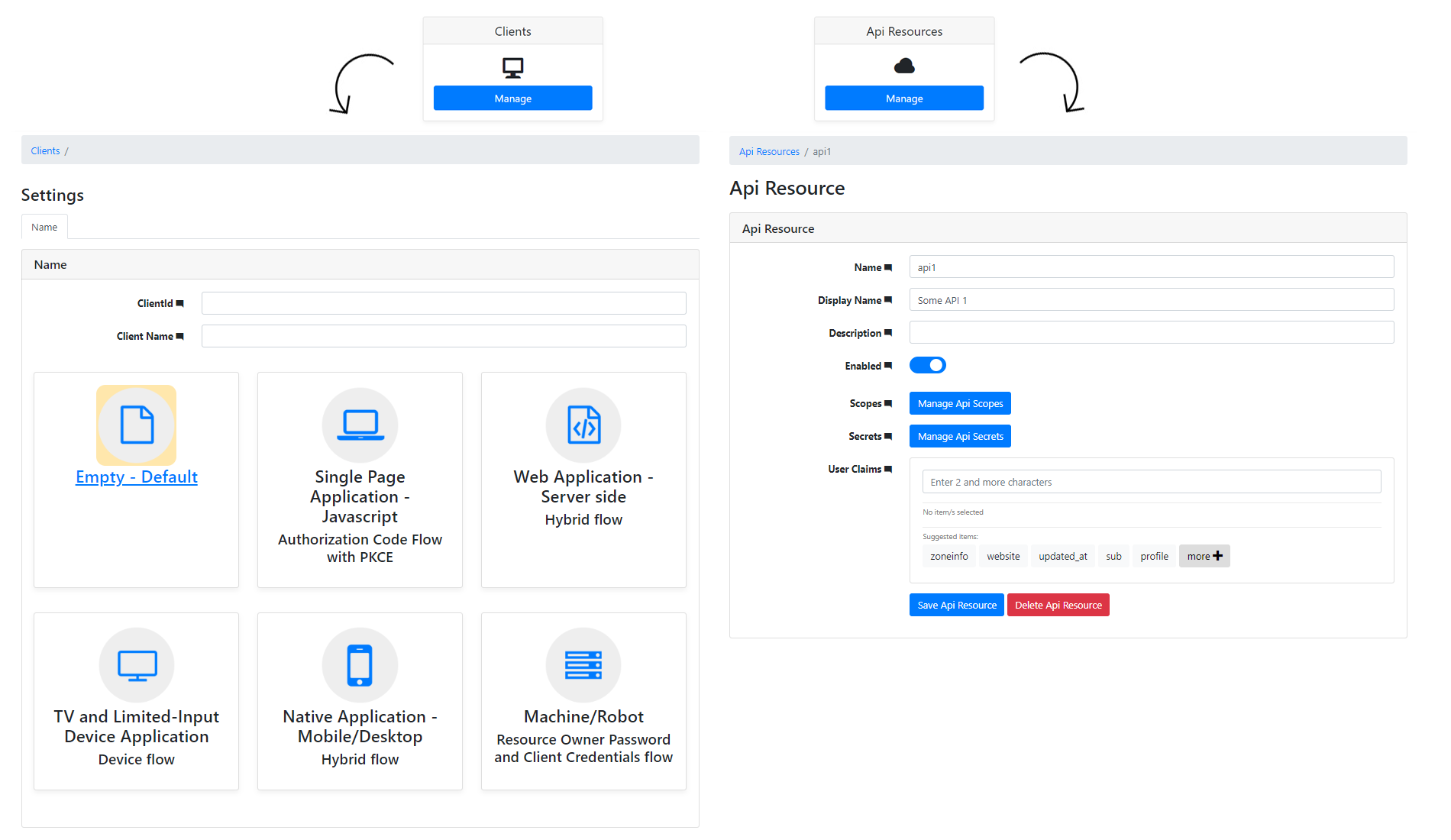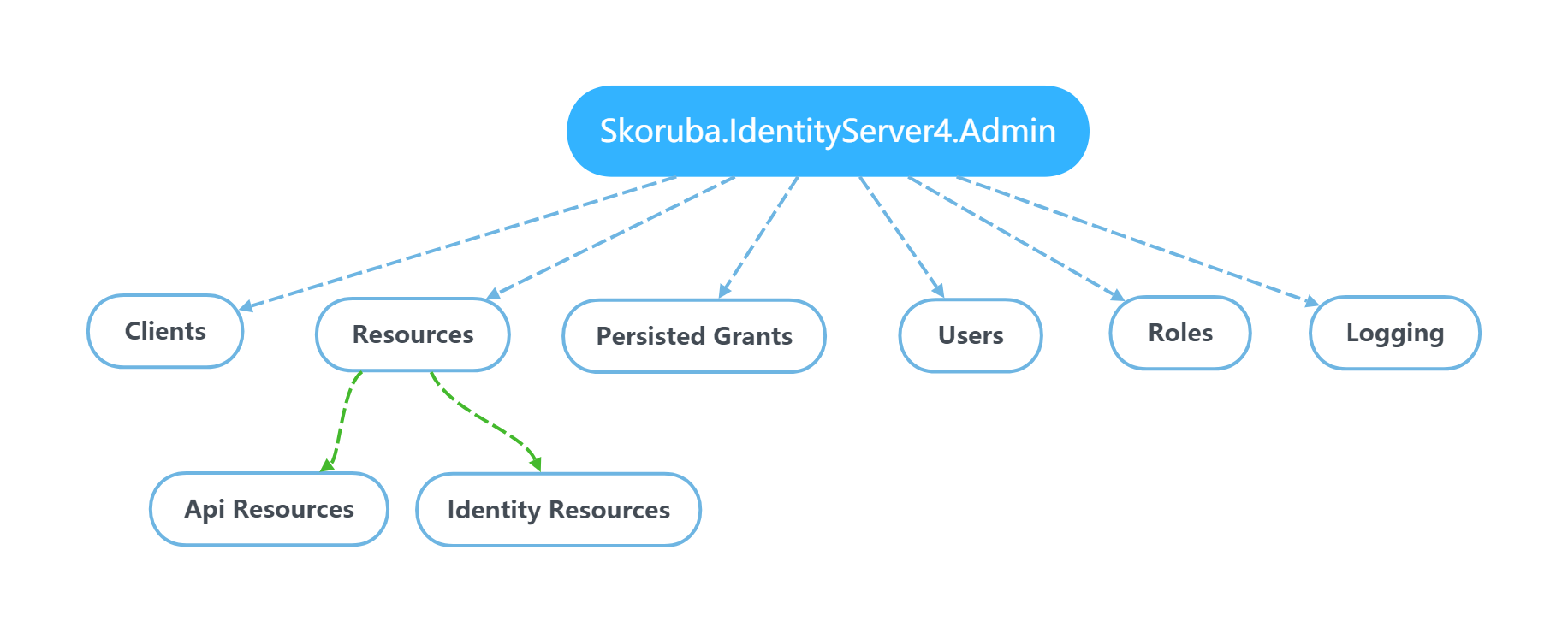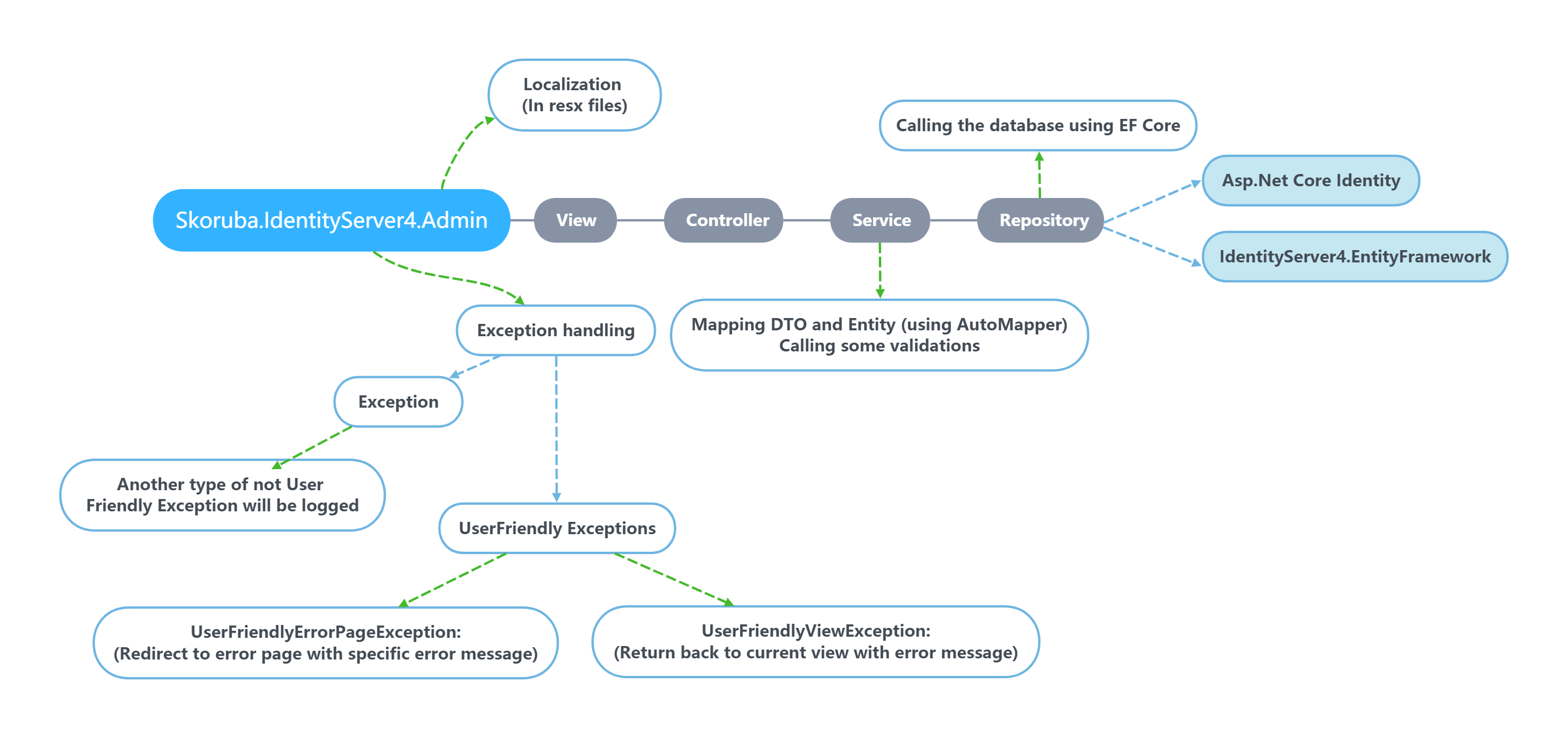The administration of the IdentityServer4 and Asp.Net Core Identity
The application is written in the Asp.Net Core MVC - using .NET Core 3.1
NOTE: Works only with IdentityServer4 version 3.0.0 and higher 🚀
- Install the latest .NET Core 3.x SDK (using older versions may lead to 502.5 errors when hosted on IIS or application exiting immediately after starting when self-hosted)
- Install the dotnet new template:
dotnet new -i Skoruba.IdentityServer4.Admin.Templates::1.0.0-rc1-update2- Create new project:
dotnet new skoruba.is4admin --name MyProject --title MyProject --adminemail "admin@example.com" --adminpassword "Pa$$word123" --adminrole MyRole --adminclientid MyClientId --adminclientsecret MyClientSecret --dockersupport trueProject template options:
--name: [string value] for project name
--adminpassword: [string value] admin password
--adminemail: [string value] admin email
--title: [string value] for title and footer of the administration in UI
--adminrole: [string value] for name of admin role, that is used to authorize the administration
--adminclientid: [string value] for client name, that is used in the IdentityServer4 configuration for admin client
--adminclientsecret: [string value] for client secret, that is used in the IdentityServer4 configuration for admin client
--dockersupport: [boolean value] include docker support
- Set Startup projects:
- Skoruba.IdentityServer4.Admin
- Skoruba.IdentityServer4.Admin.Api
- Skoruba.IdentityServer4.STS.Identity
- Configuration of Admin for deploy on Azure
- Configuration of Admin on Ubuntu with PostgreSQL database
-
This administration uses bootstrap 4
-
Admin UI
- Security token service (STS)
- Forms:
git clone https://github.com/skoruba/IdentityServer4.Admin-
It is possible to run Admin UI through the docker.
-
Project contains the
docker-compose.vs.debug.ymlanddocker-compose.override.ymlto enable debugging with a seeded environment. -
The following possibility to get a running seeded and debug-able (in VS) environment:
docker-compose build
docker-compose up -d
It is also possible to set as startup project the project called
docker-composein Visual Studio.
- Docker images will be available also in docker hub
- AdminUI:
skoruba/identityserver4-admin:rc1
- Admin Api:
skoruba/identityserver4-admin-api:rc1
- STS:
skoruba/identityserver4-sts-identity:rc1
- AdminUI:
- Check the script in
build/publish-docker-images.ps1- change the profile name according to your requirements.
cd src/Skoruba.IdentityServer4.Admin
npm install
cd src/Skoruba.IdentityServer4.STS.Identity
npm installThe following Gulp commands are available:
gulp fonts- copy fonts to thedistfoldergulp styles- minify CSS, compile SASS to CSSgulp scripts- bundle and minify JSgulp clean- remove thedistfoldergulp build- run thestylesandscriptstasks
-
The solution uses these
DbContexts:AdminIdentityDbContext: for Asp.Net Core IdentityAdminLogDbContext: for loggingIdentityServerConfigurationDbContext: for IdentityServer configuration storeIdentityServerPersistedGrantDbContext: for IdentityServer operational storeAuditLoggingDbContext: for Audit Logging
NOTE: Initial migrations are a part of the repository.
-
It is possible to use powershell script in folder
build/add-migrations.ps1. -
This script take two arguments:
- --migration (migration name)
- --migrationProviderName (provider type - available choices: All, SqlServer, MySql, PostgreSQL)
-
For example:
.\add-migration.ps1 -migration DbInit -migrationProviderName SqlServer
- SqlServer
- MySql
- PostgreSQL
It is possible to switch the database provider via
appsettings.json:
"DatabaseProviderConfiguration": {
"ProviderType": "SqlServer"
}
PostgreSQL:
Server=localhost;Port=5432;Database=IdentityServer4Admin;User Id=sa;Password=#;
MySql:
server=localhost;database=IdentityServer4Admin;user=root;password=#
- In
Program.cs->Main, uncommentDbMigrationHelpers.EnsureSeedData(host)or use dotnet CLIdotnet run /seed - The
ClientsandResourcesfiles inidentityserverdata.json(section called: IdentityServerData) - are the initial data, based on a sample from IdentityServer4 - The
Usersfile inidentitydata.json(section called: IdentityData) contains the default admin username and password for the first login
- Change the specific URLs and names for the IdentityServer and Authentication settings in
appsettings.json - In the controllers is used the policy which name is stored in -
AuthorizationConsts.AdministrationPolicy. In the policy -AuthorizationConsts.AdministrationPolicyis defined required role stored in -appsettings.json-AdministrationRole. - With the default configuration, it is necessary to configure and run instance of IdentityServer4. It is possible to use initial migration for creating the client as it mentioned above
-
We are using
Serilogwith pre-definded following Sinks - white are available inserilog.json:- Console
- File
- MSSqlServer
{
"Serilog": {
"MinimumLevel": {
"Default": "Error",
"Override": {
"Skoruba": "Information"
}
},
"WriteTo": [
{
"Name": "Console"
},
{
"Name": "File",
"Args": {
"path": "log.txt",
"rollingInterval": "Day"
}
},
{
"Name": "MSSqlServer",
"Args": {
"connectionString": "...",
"tableName": "Log",
"columnOptionsSection": {
"addStandardColumns": [ "LogEvent" ],
"removeStandardColumns": [ "Properties" ]
}
}
}
]
}
}- This solution uses audit logging via - https://github.com/skoruba/AuditLogging (check this link for more detal about this implementation 😊)
- In the Admin UI project is following setup:
services.AddAuditLogging(options => { options.Source = auditLoggingConfiguration.Source; })
.AddDefaultHttpEventData(subjectOptions =>
{
subjectOptions.SubjectIdentifierClaim = auditLoggingConfiguration.SubjectIdentifierClaim;
subjectOptions.SubjectNameClaim = auditLoggingConfiguration.SubjectNameClaim;
},
actionOptions =>
{
actionOptions.IncludeFormVariables = auditLoggingConfiguration.IncludeFormVariables;
})
.AddAuditSinks<DatabaseAuditEventLoggerSink<TAuditLog>>();
// repository for library
services.AddTransient<IAuditLoggingRepository<TAuditLog>, AuditLoggingRepository<TAuditLoggingDbContext, TAuditLog>>();
// repository and service for admin
services.AddTransient<IAuditLogRepository<TAuditLog>, AuditLogRepository<TAuditLoggingDbContext, TAuditLog>>();
services.AddTransient<IAuditLogService, AuditLogService<TAuditLog>>();In appsettings.json is following configuration:
"AuditLoggingConfiguration": {
"Source": "IdentityServer.Admin.Web",
"SubjectIdentifierClaim": "sub",
"SubjectNameClaim": "name",
"IncludeFormVariables": false
}The Skoruba.IdentityServer4.Admin.BusinessLogic layer contains folder called Events for audit logging. In each method in Services is called function LogEventAsync like this:
await AuditEventLogger.LogEventAsync(new ClientDeletedEvent(client));
Final audit log is available in the table dbo.AuditLog.
- In
Skoruba.IdentityServer4.STS.Identity- inappsettings.jsonis possible to specify which column will be used for login (UsernameorEmail):
"LoginConfiguration": {
"ResolutionPolicy": "Username"
}
or using Email:
"LoginConfiguration": {
"ResolutionPolicy": "Email"
}
- In
Skoruba.IdentityServer4.STS.Identity- inappsettings.jsonis possible to disable user registration (default: true):
"RegisterConfiguration": {
"Enabled": false
}
- For development is running on url -
http://localhost:5001and swagger UI is available on url -http://localhost:5001/swagger - For swagger UI is configured a client and an API in STS:
"AdminApiConfiguration": {
"IdentityServerBaseUrl": "http://localhost:5000",
"OidcSwaggerUIClientId": "skoruba_identity_admin_api_swaggerui",
"OidcApiName": "skoruba_identity_admin_api"
}
- Swagger UI contains following endpoints:
- In
Skoruba.IdentityServer4.STS.Identity/Helpers/StartupHelpers.cs- is method calledAddExternalProviderswhich contains the example withGitHuband inappsettings.json:
"ExternalProvidersConfiguration": {
"UseGitHubProvider": false,
"GitHubClientId": "",
"GitHubClientSecret": ""
}
- It is possible to extend
ExternalProvidersConfigurationwith another configuration properties.
- https://github.com/aspnet-contrib/AspNet.Security.OAuth.Providers
- https://docs.microsoft.com/en-us/aspnet/core/security/authentication/social/
- Great article how to set up Azure AD:
- It is possible to set up emails via:
In STS project - in appsettings.json:
"SendgridConfiguration": {
"ApiKey": "",
"SourceEmail": "",
"SourceName": ""
}
"SmtpConfiguration": {
"Host": "",
"Login": "",
"Password": ""
}
- AdminUI, AdminUI Api and STS contain endpoint
health, which check databases and IdentityServer.
- The project has following translations:
- English
- Chinese
- Russian
- Persian
- Swedish
- Danish
- Spanish
- French
- Finish
-
All labels and messages are stored in the resources
.resx- locatated in/Resources- Client label descriptions from - http://docs.identityserver.io/en/latest/reference/client.html
- Api Resource label descriptions from - http://docs.identityserver.io/en/latest/reference/api_resource.html
- Identity Resource label descriptions from - http://docs.identityserver.io/en/latest/reference/identity_resource.html
- The solution contains unit and integration tests.
Integration tests use StartupTest class which is pre-configured with:
DbContextcontains setup for InMemory databaseAuthenticationis setup forCookieAuthentication- with fake login url for testing purpose onlyAuthenticatedTestRequestMiddleware- middleware for testing of authentication.
-
STS:
Skoruba.IdentityServer4.STS.Identity- project that contains the instance of IdentityServer4 and combine these samples - Quickstart UI for the IdentityServer4 with Asp.Net Core Identity and EF Core storage and damienbod - IdentityServer4 and Identity template
-
Admin UI Api:
Skoruba.IdentityServer4.Admin.Api- project with Api for managing data of IdentityServer4 and Asp.Net Core Identity, with swagger support as well
-
Admin UI:
-
Skoruba.IdentityServer4.Admin- ASP.NET Core MVC application that contains Admin UI -
Skoruba.IdentityServer4.Admin.BusinessLogic- project that contains Dtos, Repositories, Services and Mappers for the IdentityServer4 -
Skoruba.IdentityServer4.Admin.BusinessLogic.Identity- project that contains Dtos, Repositories, Services and Mappers for the Asp.Net Core Identity -
Skoruba.IdentityServer4.Admin.BusinessLogic.Shared- project that contains shared Dtos and ExceptionHandling for the Business Logic layer of the IdentityServer4 and Asp.Net Core Identity -
Skoruba.IdentityServer4.Admin.EntityFramework- EF Core data layer that contains Entities for the IdentityServer4 -
Skoruba.IdentityServer4.Admin.EntityFramework.Identity- EF Core data layer that contains Repositories for the Asp.Net Core Identity -
Skoruba.IdentityServer4.Admin.EntityFramework.Extensions- project that contains extensions related to EntityFramework -
Skoruba.IdentityServer4.Admin.EntityFramework.Shared- project that contains DbContexts for the IdentityServer4, Logging and Asp.Net Core Identity, inluding shared Identity entities -
Skoruba.IdentityServer4.Admin.EntityFramework.SqlServer- project that contains migrations for SqlServer -
Skoruba.IdentityServer4.Admin.EntityFramework.MySql- project that contains migrations for MySql -
Skoruba.IdentityServer4.Admin.EntityFramework.PostgreSQL- project that contains migrations for PostgreSQL
-
-
Tests:
-
Skoruba.IdentityServer4.Admin.IntegrationTests- xUnit project that contains the integration tests for AdminUI -
Skoruba.IdentityServer4.Admin.Api.IntegrationTests- xUnit project that contains the integration tests for AdminUI Api -
Skoruba.IdentityServer4.Admin.UnitTests- xUnit project that contains the unit tests for AdminUI -
Skoruba.IdentityServer4.STS.IntegrationTests- xUnit project that contains the integration tests for STS
-
Clients
It is possible to define the configuration according the client type - by default the client types are used:
-
Empty
-
Web Application - Server side - Hybrid flow
-
Single Page Application - Javascript - Authorization Code Flow with PKCE
-
Native Application - Mobile/Desktop - Hybrid flow
-
Machine/Robot - Resource Owner Password and Client Credentials flow
-
TV and Limited-Input Device Application - Device flow
-
Actions: Add, Update, Clone, Remove
-
Entities:
- Client Cors Origins
- Client Grant Types
- Client IdP Restrictions
- Client Post Logout Redirect Uris
- Client Properties
- Client Redirect Uris
- Client Scopes
- Client Secrets
API Resources
- Actions: Add, Update, Remove
- Entities:
- Api Claims
- Api Scopes
- Api Scope Claims
- Api Secrets
- Api Properties
Identity Resources
- Actions: Add, Update, Remove
- Entities:
- Identity Claims
- Identity Properties
Users
- Actions: Add, Update, Delete
- Entities:
- User Roles
- User Logins
- User Claims
Roles
- Actions: Add, Update, Delete
- Entities:
- Role Claims
- Create the Business Logic & EF layers - available as a nuget package
- Create a project template using dotnet CLI -
dotnet new template- First template: The administration of the IdentityServer4 and Asp.Net Core Identity
- Add logging into
- Database
- File
- Add localization for other languages
- English
- Chinese
- Russian
- Persian
- Swedish
- Danish
- Spanish
- French
- Finish
- Manage profile
- Password reset
- Link account to an external provider (example with Github)
- Two-Factor Authentication (2FA)
- User registration
- Email service
- SendGrid
- Add API
- IdentityServer4
- Asp.Net Core Identity
- Add swagger support
- Add audit logs to track changes (#61)
- Docker support (#121)
- Health Checks (Databases and IdentityServer)
- Support for multiple database providers (SqlServer, Mysql, PostgreSQL)
- Create a project template using dotnet CLI -
dotnet new template- Second template: The administration of the IdentityServer4 (without Asp.Net Core Identity) (#79)
- Add UI tests (#97, #116)
- Add more unit and integration tests 😊
- Extend administration for another protocols
- Create separate UI using
Razor Class Library(#28, #133)
This repository is licensed under the terms of the MIT license.
NOTE: This repository uses the source code from https://github.com/IdentityServer/IdentityServer4.Quickstart.UI which is under the terms of the Apache License 2.0.
This web application is based on these projects:
- ASP.NET Core
- IdentityServer4.EntityFramework
- ASP.NET Core Identity
- XUnit
- Fluent Assertions
- Bogus
- AutoMapper
- Serilog
Thanks to Tomáš Hübelbauer for the initial code review.
Thanks to Dominick Baier and Brock Allen - the creators of IdentityServer4.
Thanks goes to these wonderful people (emoji key):
Jan Škoruba 💻 💬 📖 💡 🤔 |
Tomáš Hübelbauer 💻 👀 📖 🤔 |
Michał Drzał 💻 👀 📖 💡 🤔 |
cerginio 💻 🐛 💡 🤔 |
Sven Dummis 📖 |
Seaear 💻 🌍 |
|---|---|---|---|---|---|
Rune Antonsen 🐛 |
Sindre Njøsen 💻 |
Alevtina Brown 🌍 |
Brice 💻 |
TheEvilPenguin 💻 |
Saeed Rahmani 🌍 |
Andy Yu 🌍 |
ChrisSzabo 💻 |
aiscrim 💻 💡 🤔 |
HrDahl 🌍 |
Andrew Godfroy 📖 |
bravecobra 💻 |
Sabit Igde 💻 |
Rico Herlt 💻 |
b0 💻 |
DrQwertySilence 🌍 |
Carl Quirion 💻 |
Aegide 🌍 |
LobsterBandit 💻 |
Mehmet Perk 💻 |
tapmui 🌍 |
Saeed Rahimi 💻 |
This project follows the all-contributors specification. Contributions of any kind are welcome!
I am happy to share my attempt of the implementation of the administration for IdentityServer4 and ASP.NET Core Identity.
Any feedback is welcome - feel free to create an issue or send me an email - jan@skoruba.com. Thank you 😊
If you like my work, you can support me by donation. 👍

